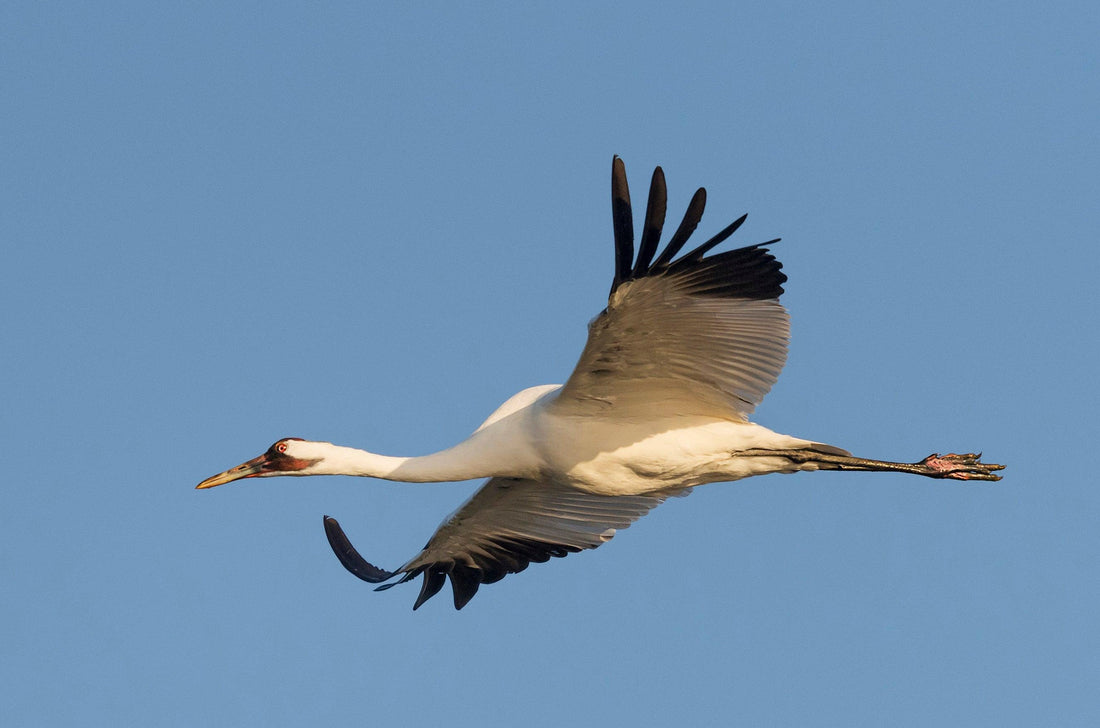
Fun Facts About Whooping Cranes
Share
Whooping cranes are majestic creatures that captivate the hearts of bird enthusiasts and nature lovers alike. These magnificent birds have a fascinating history and possess unique characteristics that set them apart from other species. In this blog post, we will explore five fun facts about whooping cranes that you may not have known before, delving deeper into their intriguing world.
The Comeback Story
Whooping cranes have an incredible conservation success story. At one point, their population had dwindled to only 15 individuals in the wild, making them one of the most endangered bird species in the world. The Endangered Species Act played a crucial role in protecting the species and supporting recovery efforts during this critical time. The situation seemed dire, and the possibility of extinction loomed large. Thanks to the tireless efforts of dedicated conservationists and various organizations committed to saving these birds, their numbers have slowly increased over the years. A key factor in this recovery was the captive breeding program initiated in 1967 at the Patuxent Wildlife Research Center, where eggs from wild populations were transferred to increase the species' numbers and manage genetic health, ultimately facilitating the rearing and release of chicks back into the wild. Today, there are over 800 whooping cranes in the wild, a remarkable recovery considering their near-extinction. Establishing a self sustaining population in the wild remains a key milestone in ongoing conservation efforts. The original flock migrates between Texas and northern Canada, and this traditional migration route has played a significant role in the species' recovery story. This inspiring comeback story serves as a testament to the power of conservation and the resilience of nature. Their journey from the brink of extinction to a slowly growing population is nothing short of miraculous and highlights the importance of continued conservation efforts.
Impressive Size and Wingspan
Not only are whooping cranes known for their remarkable recovery, but they also hold the title for being the tallest birds in North America. The whooping crane (Grus americana) stands at an impressive height of around five feet tall. Cranes are the tallest bird species in their regions, with whooping cranes being the tallest in North America. Additionally, whooping cranes have a wingspan that can reach up to seven feet! Their striking black wing tips are visible in flight and help distinguish them from other cranes. Their impressive size is made possible by their hollow bones, which keep them light enough for flight despite their height. Imagine witnessing the graceful flight of these enormous creatures as they soar through the sky. Their size and wingspan make them an awe-inspiring sight to behold. The sheer majesty of seeing a whooping crane spread its wings and take to the air is a spectacle that leaves a lasting impression on anyone fortunate enough to witness it.
Where in the World?
Whooping cranes are true globetrotters of North America, with a fascinating range that stretches from the far north to the southern coasts. The original flock of whooping cranes, often called the Western flock, makes an epic journey each year, breeding in the remote wetlands of Wood Buffalo National Park in northern Canada and spending the winter months in the mild climate of the Aransas National Wildlife Refuge in Texas. This main flock, which has slowly grown over the years, is now nearly 300 strong—a testament to their resilience and the success of ongoing conservation efforts.
But whooping cranes aren’t just found in one place. Thanks to dedicated reintroduction programs, there are now three reintroduced populations in North America, including groups in Wisconsin, Louisiana, and Florida. These majestic birds, the tallest bird in North America, prefer habitats like bogs, marshes, and lowland wetlands, which provide the perfect environment for nesting and raising their young. Whether they’re wading through the shallow waters of their breeding grounds or foraging in their wintering habitats, whooping cranes are a remarkable sight—standing tall and proud as one of the most iconic birds in North America.
What’s for Dinner?
When it comes to mealtime, whooping cranes are not picky eaters! These resourceful birds are omnivores, meaning their menu is as diverse as the wetlands they call home. During the winter months, whooping cranes love to feast on blue crabs and wolfberries along the Gulf Coast, making the most of the seasonal bounty. In their northern breeding grounds, their diet shifts to include small fish, amphibians, insects, and even small mammals. Berries and other plant materials also make regular appearances on their plates.
As they migrate, whooping cranes often stop in agricultural fields to snack on leftover grain, showing just how adaptable they can be. Adult whooping cranes play a vital role in teaching young whooping cranes the art of foraging, passing down essential survival skills from one generation to the next. Whether they’re delicately plucking a blue crab from the mud or hunting for insects in a grassy marsh, these cranes are true foraging experts, perfectly adapted to the ever-changing menu of their wetland habitats.
Migratory Marvels
The whooping crane migrates long distances between its breeding grounds and wintering grounds. They travel over 2,500 miles each way between their breeding grounds in Canada and their wintering grounds along the Gulf Coast of the United States. The cranes breed in the Northwest Territories, particularly in Wood Buffalo National Park, which is a key habitat for their survival. After reaching the southern United States, the whooping crane winters in the coastal marshes of Texas, where suitable wetland habitats are crucial for their survival. What makes their migration even more fascinating is that they follow the same routes year after year, using landmarks and environmental cues to navigate. Whooping cranes live across a wide range of habitats in North America, from their northern breeding grounds to their southern wintering areas. This remarkable ability to navigate such vast distances showcases the intelligence and adaptability of these magnificent birds. The consistency and reliability of their migratory patterns are a testament to their enduring connection with the natural world and their instinctual drive to survive.
Unique Courtship Dance
One of the most fascinating aspects of whooping cranes is their unique courtship dance. Whooping cranes mate for life, forming long-term pair bonds. During the breeding season, male cranes perform an elaborate dance to attract a mate. This dance involves intricate movements, such as bowing, jumping, and flapping their wings. The male cranes also call out with a distinctive whooping sound, which gives them their name.
After the courtship dance, whooping cranes typically lay two eggs in a nest each breeding season. The nest is carefully constructed in wetlands to protect the eggs and future chicks. Usually, only one chick survives to fledge, highlighting the challenges of chick rearing in the wild.
This courtship display is not only a beautiful spectacle but also a way for cranes to establish pair bonds and ensure successful reproduction. The dance is a complex and mesmerizing ritual that underscores the deep emotional and social bonds these birds form with their partners, making it a critical aspect of their reproductive success.
Danger Zone: Threats and Predators
Life in the wild isn’t always easy for whooping cranes. These endangered whooping cranes face a host of natural and human-made threats that challenge their survival. While adult whooping cranes can often escape danger by taking flight, young cranes are especially vulnerable to predators like foxes, coyotes, hawks, wolves, wolverines, and even wild bears. The parents work tirelessly to protect their chicks, but the risks remain high.
Beyond natural predators, whooping cranes have also suffered from illegal hunting and the ongoing loss of their wetland habitats. Modern dangers such as collisions with power lines and the unpredictable effects of climate change add to the challenges facing the whooping crane population. Thankfully, organizations like the International Crane Foundation work around the clock to safeguard these magnificent birds and their habitats. Through education, advocacy, and hands-on conservation, they’re helping to ensure that whooping cranes continue to grace the skies of North America for generations to come.
Crane Detectives: Research and Tracking
Unlocking the mysteries of whooping crane behavior and migration has taken some creative detective work! Researchers use various innovative tools to study this endangered species, from tracking devices to ultralight aircraft that help guide young cranes along safe migration routes. Captive breeding programs, such as those at the Patuxent Wildlife Research Center and the International Crane Foundation, have played a crucial role in boosting the whooping crane population. These programs involve carefully collecting whooping crane eggs, using artificial insemination to produce fertile eggs, and raising chicks in controlled environments before releasing them into the wild.
The Fish and Wildlife Service also plays a key role in these conservation efforts, working alongside scientists and conservationists to monitor cranes, protect their habitats, and ensure the species' long-term survival. By studying whooping cranes up close, researchers gain valuable insights into their needs and behaviors, helping to shape the future of conservation for one of North America’s most iconic birds. Every egg, every migration, and every new discovery brings us one step closer to securing a brighter future for the whooping crane.
Longevity and Family Bonds
Whooping cranes are known for their long lifespan and strong family bonds. These birds can live up to 30 years in the wild and even longer in captivity. They form monogamous pairs that stay together for life, raising their chicks together. The parents take turns incubating the eggs and caring for the young, showing a remarkable level of dedication and cooperation. This strong family structure contributes to the survival and success of the species. The deep familial ties and cooperative parenting strategies of whooping cranes highlight the importance of social bonds in the animal kingdom and provide valuable insights into their behavior and life cycle.
Bringing Wayne the Whooping Crane into your home also leads directly to conservation efforts for these majestic birds - a portion of every purchase goes directly to the International Crane Foundation.
Whooping cranes are not only beautiful creatures but also hold remarkable stories and characteristics. From their incredible recovery to their impressive size, migratory abilities, unique courtship dance, and strong family bonds, these birds continue to captivate us with their grace and resilience. As we appreciate and learn more about whooping cranes, let us also remember the importance of protecting and conserving their habitats, ensuring their survival for generations to come. The ongoing efforts to safeguard their future are crucial, and by understanding their story, we can contribute to the preservation of these magnificent birds and the ecosystems they inhabit.
